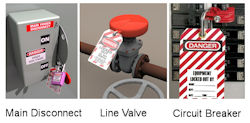Lockout Devices
Lockout devices, which are typically locks, hold energy isolation devices in a safe or "off" position.
They provide protection by physically preventing machines or equipment from becoming energized because they are substantial positive restraints that no one can remove without a key or other unlocking mechanism, or through extraordinary means, such as bolt cutters. The various types of lockout devices include:
- Circuit Breaker Lockout - Designed to help lock out most major brands of breakers. The goal of this product is to isolate a given breaker in a circuit breaker panel so that the entire breaker box does not need to be locked out.
- Valve Lockouts - Designed to prevent fluid or gas valves from being opened while repair or maintenance is occurring. This could involve ball valves (handle you turn 90° to shut off) or gate valves (round knob). Ball valve lockouts are measured by the length of the handle. Gate valve lockouts are measured by the diameter of the knob.
- Plug Lockout - Helps lock out any electrical plug up to certain diameters
- Electrical/Pneumatic Plug - This multipurpose device can lock out electrical cords and male air hose connectors
- Wall Switch Lockout - Prevents workers from tampering with switches or accidental startup of equipment. Switch can be locked in the on or off position.
- Adjustable Cable Lockout - Comes with a cable that allows for locking out a wide variety of electrical or valve lockouts and accommodates multiple padlocks
- Hasp - Allows more than one worker to put their padlock on an energy control device when more than one worker is performing maintenance on a given piece of equipment
- Group Lock Box or Gang Box - Commonly used to lock out very large pieces of equipment that have multiple work functions affecting the maintenance of the equipment. This box allows for each lockout point to be secured with just one designated lock. The accompanying keys are then placed in the box. Each employee locks just one personal safety lock onto the box. The captured keys cannot be removed, or the equipment re-energized until all have removed their locks from the box.
See specific examples courtesy of DEenergize.
Knowledge Check Choose the best answer for the question.
1-8. How do lockout devices physically prevent equipment and machines from being energized?
You forgot to answer the question!

